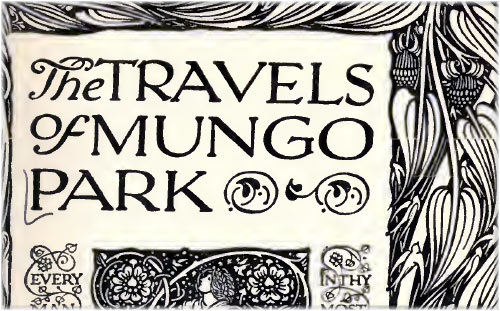Mungo Park. The Travels of Mungo Park. New York: J. M. Dent & co., E. P. Dutton & co., 1907.
Born in 1771, son of a yeoman of Ettrick Forest, the seventh of thirteen children, Mungo Park was intended for the Scottish Church, but chose the medical profession. He served his time with Mr. Anderson, a surgeon in Selkirk ; attended lectures during three sessions at Edinburgh University; and in the summer gave his leisure to botany, assisted by his brother-in-law, James Dickson, by whom he was afterwards introduced to Sir Joseph Banks. Through Banks' influence he was appointed assistant-surgeon on the Worcester, East Indiaman, and sailed to Bencoolen, Sumatra, in 1792. He returned the following year, bringing with him several rare plants for Banks. The Association for Promoting Discoveries in the Interior of Africa next appointed him (succeeding Major Houghton) to explore the course of the Niger, and he sailed from Portsmouth in May 1795.
Arriving in the Gambia, Park studied the Mandingo language, collected information at Pisania, 200 miles up the river ; left Pisania December 2, with only a negro servant and a boy, one horse, and two asses, and, after severe hardships, arrived at Sego and the Niger, to discover that its stream flowed from west to east, as Herodotus thought. We learn from his own narrative how he had eventually to return against the river, fell ill, and was saved by the care of Karfa Taura. He reached Pisania again on June 10, 1797, sailed thence in a slave ship bound for America, and eventually arrived at Falmouth on December 22, 1797. Landing in London before daylight on Christmas Day, 1797, he went to the gardens of the British Museum, to pass the time until he could call on his brother-in-law, James Dickson, "who, unexpectedly coming to the gardens on some trifling business, was deeply moved to see there his long-lost friend, whom he had long numbered among the dead."
 |


 English
English  Italiano
Italiano  Français
Français  Deutsch
Deutsch 